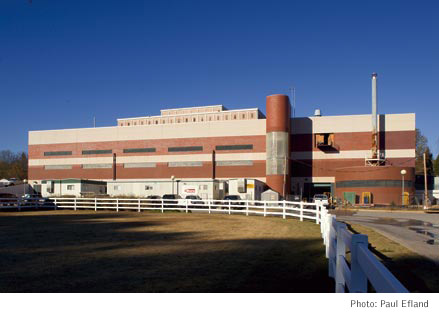


Facility Supports Research on Diseases in Animals and People
by KWB

![]()
Come this spring, University of Georgia scientist Ralph Tripp and several of his colleagues who study infectious diseases will have a new 75,000-square-foot home. Tripp, a professor of infectious disease and Georgia Research Alliance Eminent Scholar, will be one of approximately 50 people to occupy the new Animal Health Research Center (AHRC, pronounced “ark”), a $40 million facility renovation to support research in highly infectious “zoonotic” diseases, which affect animals and people alike.
AHRC is a biosafety level 3 agricultural (BSL-3-Ag) facility that enables scientists to work with pathogens such as the avian influenza virus, SARS virus, West Nile virus and other zoonotic agents. It will be the only center of its type in the Southeast and one of the few BSL-3-Ag facilities in the country to be housed at a university, said Harry Dickerson, associate dean for research and graduate affairs at UGA’s College of Veterinary Medicine.

“What’s becoming more and more clear is that a lot of the infectious diseases of concern to humans also affect animals [and can be] transferred from animals to humans,” Dickerson said. The building’s special design will enable scientists to study multiple animal species ranging in size from cattle to rodents — work that could benefit farmers battling disease in their livestock as well as fend off a possible avian flu epidemic that experts predict is on the horizon.
AHRC will house half a dozen principal scientists and their staff, who will make use of 19 labs specially constructed to ensure that the infectious agents under study cannot escape. The facility features a ventilation system that virtually sterilizes the air entering and exiting the building, a water treatment plant, back-up generators, on-site systems to destroy biological waste, clean rooms and other safety features.
“A lot of these agents were already being studied on campus, but the new facility enhances our research capability under extremely safe conditions,” Dickerson said. “We see it as a jewel in the crown” that will help the university attract research dollars and distinguished faculty and graduate students.
Efforts to inform the community about the center and its research projects already are under way with the formation of a community liaison committee that meets regularly to discuss safety concerns and educate the public on the scientists’ anticipated work. The group is made up of university faculty and staff, community members and public health officials.
Sections of the center, which is being funded mostly through state appropriations, the U.S. Department of Agriculture and a loan from the UGA Research Foundation, opened in January 2006. The remainder of the building is expected to be ready for occupancy next May.
In addition to benefiting research efforts at Georgia, Dickerson said the university also is looking into developing a consortium of neighboring universities that might benefit from access to the new center. “This could help develop research capacities in veterinary medicine and infectious diseases here and at other schools in the region,” he said. “It also could help to develop multi-university research collaborations. This building makes Georgia a place where that’s going to happen.”
For comments or for information please e-mail: rcomm@uga.edu
To contact the webmaster please email: ovprweb@uga.edu
![]()